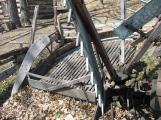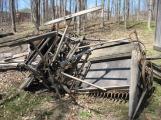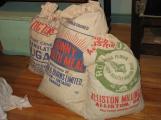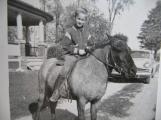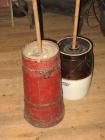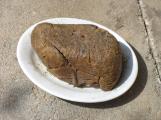1
Let's see what the family remembers about farming, and the chores they had to perform associated with that.3
Scale model of the farm, circa 1920.During William Banting's tenure, he kept a herd of shorthorn cattle. Early crops were dedicated to supporting the cattle. "Hay and silage were the order of the day," Robert Douglas Banting, William's great-grandson, reports. "They had a large garden and an orchard. The orchard was in front (east) of the original house and on the north toward the location of the original barn. This small barn, built by the Meredith's, was north of the house and it burned. William replaced the barn by building west of the house."
"Later, William started growing potatoes and son Thompson carried on this tradition. Edward carried on with the spuds when he took ownership. During crop rotations a large grain crop was grown. The current barn contains some huge granaries."
5
A wood reaper, from another local Alliston farm. Reapers were used to harvest grain.Cousin and close friend to Sir Frederick Banting, Frederick Hipwell recalls farm life in those days, and its effect on the young Banting:
"Farming did not encourage any lazy habits; there were many chores, but he never complained and was always interested in whatever might be his allotted task. Those early days were not wasted. He acquired a remarkable amount of practical information on agricultural subjects which in later life often surprised experts."
7
A wooden binder, local to the area. Similar to reapers, binders made the job slightly easier by tying up ("binding") the sheaves of grain.Frederick Banting would later recall regular Sunday evening strolls with his parents back to the fields, to check on the progress of the crops.
His niece, Helen (Banting) Jackson, recalls walks on the farm with her Uncle Fred: "Any time he came home in the summer time, he would gather us together to go out hunting for four-leafed clovers. He usually got as many as all the rest of us put together. It was strange the way that he would say, 'There should be quite a few over there,' pointing to a spot a good many yards away, and sure enough, he'd pick them out almost as fast as he could pick a bouquet of flowers."
9
Marie (Banting) Shields, Thompson's daughter, remembers plowing on the farm:"I was a tomboy. So I usually was hanging on to my dad's coattails, following him around most of the time ... I always dragged around an old potato sack with me -- well it wasn't an old one, it was a good clean one. My dad would put it on the horse's back when he was plowing, and I'd sit on it until I got tired and fell asleep, and he'd use it for a blanket at the end of the row, but I'd sleep until I got past the [ …] One day my shoe fell off and he buried it with the plow. ... Dad had to dig for it."
11
Robert Thompson Banting, Thompson's grandson, enjoys his summer holiday on the farm with an equine friend.When Thompson first began farming, the work was done by horses. In the 1940s, he replaced the six work-horses replaced with tractors. His son Edward purchased a combine in 1952.
"On two alternating summers, my brother and I worked on the farm driving the combines - a tiring and dusty job," Robert Thompson recalls.
13
Sample butter churns.Marie (Banting) Shields remembers:
"My earliest recollections … I can remember my grandfather, that was William Banting, coming out to the farm to churn. They always churned their own butter."

